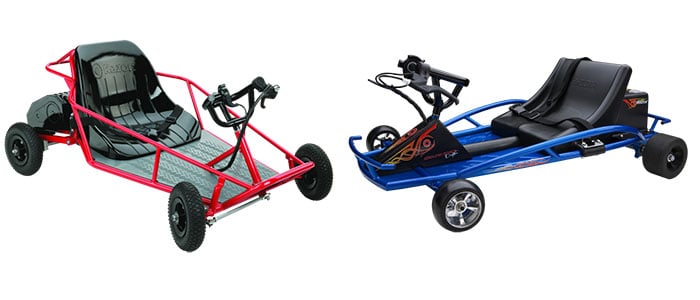In this article, we compare the Razor Dune Buggy vs Razor Ground Force Drifter – both are a good choice if you want to treat the young karting fan in your family to a fun electric go kart, designed specifically with kids in mind.
But there are some big differences between the two models. Our guide below will show you which is the most suitable for your child.
First we’ve got a quick comparison table of the key features of the Razor Dune Buggy vs Drifter. Then we look at the main differences between them and the advantages of each go kart, in turn.
Finally, we’ll summarize the pros and cons of both rides, to help you make the right choice.
Razor Dune Buggy vs Drifter – Quick Comparison
Let’s take a closer look at these electric vehicles from Razor to see how they differ.
In the table below we’ve summarized the main features of each kart in a side by side comparison, to make it easy to spot the differences between them.
| Razor Dune Buggy | Razor Ground Force Drifter | |
|---|---|---|
 |  | |
| Description | Classic electric dune buggy for racing and light off-roading | Electric drifter kart with slick rear wheels for drifts and power slides |
| Age Range | 5-10 * (see Note below) | 8+ |
| Weight Limit | 120 lbs | 140 lbs |
| Top Speed | 9 mph | 12 mph |
| Price | $$$ Check Price | $$$ Check Price |
| Battery System | 24V (2 x 12V) sealed lead acid - charger included | 24V (2 x 12V) sealed lead acid - charger included |
| Battery Life | Up to 40 minutes of continuous use | Up to 40 minutes of continuous use |
| Battery Recharge Time | 12 hours | 12 hours |
| Motor and Gearing | 350W, high torque, gear reduction, chain driven | 250W, high-torque, chain driven |
| Throttle | Variable speed with thumb tab | Variable speed with thumb trigger |
| Brake | Hand operated rear disc | Hand operated rear drum |
| Suspension | Rear with coil shock | None |
| Roll cage | Medium | Small |
| Safety Belt and Flag | Yes | Yes |
| Frame | Powder coated tubular frame for all weather durability | Steel frame |
| Seat | Padded, bucket style | Durable, bucket style |
| Handlebars | Adjustable height | Fixed |
| Tires | Steel wheels with 8” pneumatic knobby tires | Front 4" aluminum, solid rubber tires. Rear 4" Super Slider POM (thermoplastic) |
| Product Weight | 65 lbs | 58 lbs |
| Assembled Dimensions | 41” x 26.5” x 17.5” | 39.5" x 26.5" x 16" |
| Assembly Time | 5 minutes | 20 minutes |
* Note: Razor’s recommended age for the Dune Buggy is a very conservative 8+ but an age range of 5-10 (real world guide from many buyers) with parental supervision may be more suitable as it is quite small. Kids over 10 may find it too small.
Main Differences
The biggest differences between both go karts are the size and age of driver that each was designed for, plus the type of terrain that each is suited to.
Although it has a more powerful motor (350W vs 250W) the Razor Dune Buggy is 12% heavier than the Ground Force Drifter and therefore has a slower top speed (9 mph vs 12 mph). The Dune Buggy also only supports a driver weighing up to 120 pounds, compared to 140 lbs in the Drifter.
The Dune Buggy is most suitable for those aged 5 to 10 whereas the Drifter is more suitable for kids over 8 years of age, including small teens.
Another key difference is that the Dune Buggy is a classic racing go kart, equally at home on grass, dirt or concrete. But the Ground Force Drifter has slippy rear wheels which are limited to flat hard surfaces – it takes more time and maturity to learn to drive.
Check out the video below to see the Razor Dune Buggy in action on the dirt and off-road:
For comparison, the video below shows the Razor Drifter in action on concrete and indoor surfaces:
Advantages of Razor Dune Buggy
The Razor Dune Buggy was the top choice for kids under 10 in our recent review of the best go karts and dune buggies for kids.
It is 99% pre-built right out of the box so it is even easier and quicker to assemble than the Drifter which can take 20 minutes or more, depending on your experience. Other advantages include:
- Adjustable height handlebars = can adapt to a growing child
- Rear suspension = better off-roading capability (Drifter has no suspension so the ride is stiff and best suited to hard flat surfaces)
- Larger wheels = better height for off-road and improved ride comfort (8″ wheels vs 4″ on the Drifter)
- Pneumatic knobby tires = good grip for most terrain (Drifter’s slick wheels make it tail happy – better for fun and tricks on hard flat surfaces)
- Rear disc brake = better stopping ability (Drifter has a rear drum brake)
- Bigger side roll cage = safer for young kids
- Lower top speed = less scary/risky for very young kids
Advantages of Razor Ground Force Drifter
The Razor Ground Force Drifter kart is an exhilarating drifter with slick wheels for fishtails and 180 turns.
Although both vehicles can be stored upright to save space, the Drifter is 12% lighter than the Dune Buggy (58 lbs vs 65 lbs) so it is slightly easier to lift it up or hang for storage. Other advantages include:
- MSRP (Manufacturer’s Suggested Retail Price) is about $70 cheaper than the Dune Buggy – but check the actual price below
- Faster top speed (12 mph vs 9 mph)
- Higher maximum weight capacity (140 lbs vs 120 lbs)
- Super-slick rear wheels = good for drifting and sliding through corners
- Spark Bar at rear = leaves a shower of sparks in its wake for some extra bling
Pros of Both
Here is a summary of what we love about both models:
- Specifically designed for children or early teens
- Easy to recharge the battery using house electric supply
- User friendly controls
- Fast enough to give children an adrenaline rush
- Slow and stable enough to minimize the risk of your child rolling the kart or being thrown off/out – seat belts help too
- Side roll cage – creates a barrier between the driver and the outside
- Safety flag at the rear – lets the driver be seen more easily (optional, you don’t have to install it)
- No pollution (compared to a gas go kart)
- Quieter than a gas go kart and needs much less servicing
- Razor is a US manufacturer – replacement parts are available from their website
Cons of Both
Here is a summary of what we don’t like so much about both models:
- Relatively short battery life per full charge. But 40 minutes is still enough to cover about 6 to 8 miles respectively
- Battery recharge time is 12 hours so charging needs to be planned (or you could buy spare batteries to switch over instantly)
- No reverse gear so can be awkward to maneuver in tight spaces
- Helmet and protective clothing (see our Go Kart FAQ for recommended safety gear) may be uncomfortable in hot weather
- Not as high top speed as many gas go karts
- Batteries must not be stored in temperatures below freezing and must be recharged at least once a month to keep them fully operational
Owner’s Manuals
The owner’s manual for the Razor Dune Buggy is available in PDF format from Razor here.
The owner’s manual for the Razor Ground Force Drifter is available in PDF format from Razor here.
NOTE: A parent’s decision to allow their child to drive either the Razor Dune Buggy or the Razor Ground Force Drifter should depend on the child’s individual maturity, skill and ability to follow rules.

